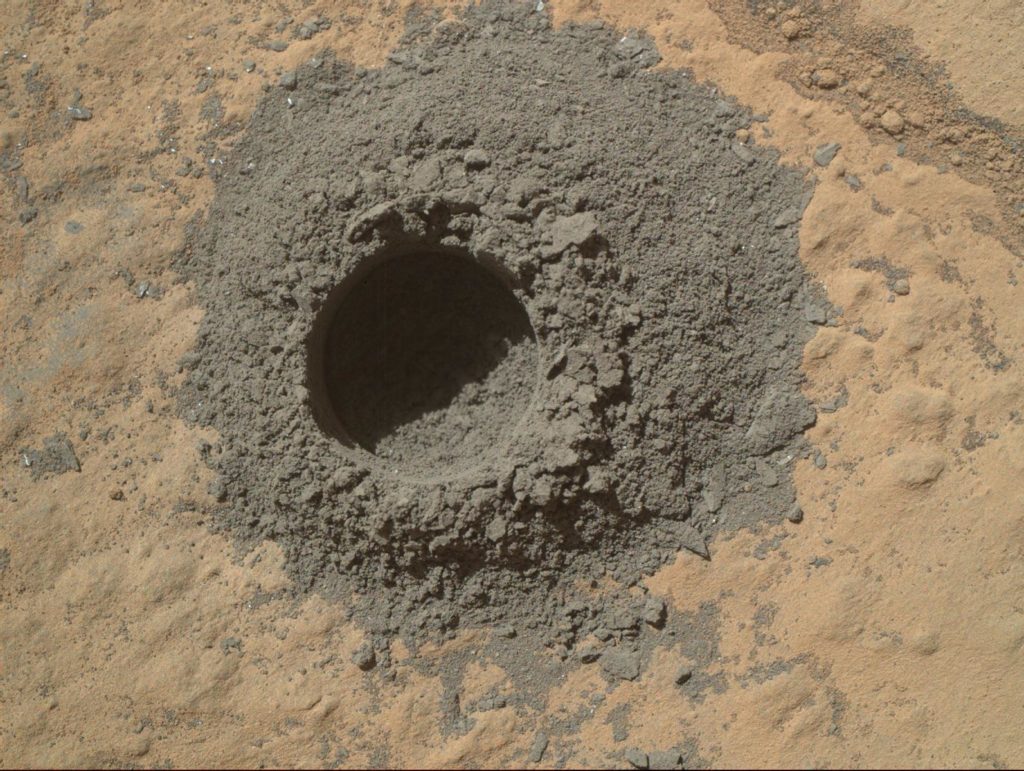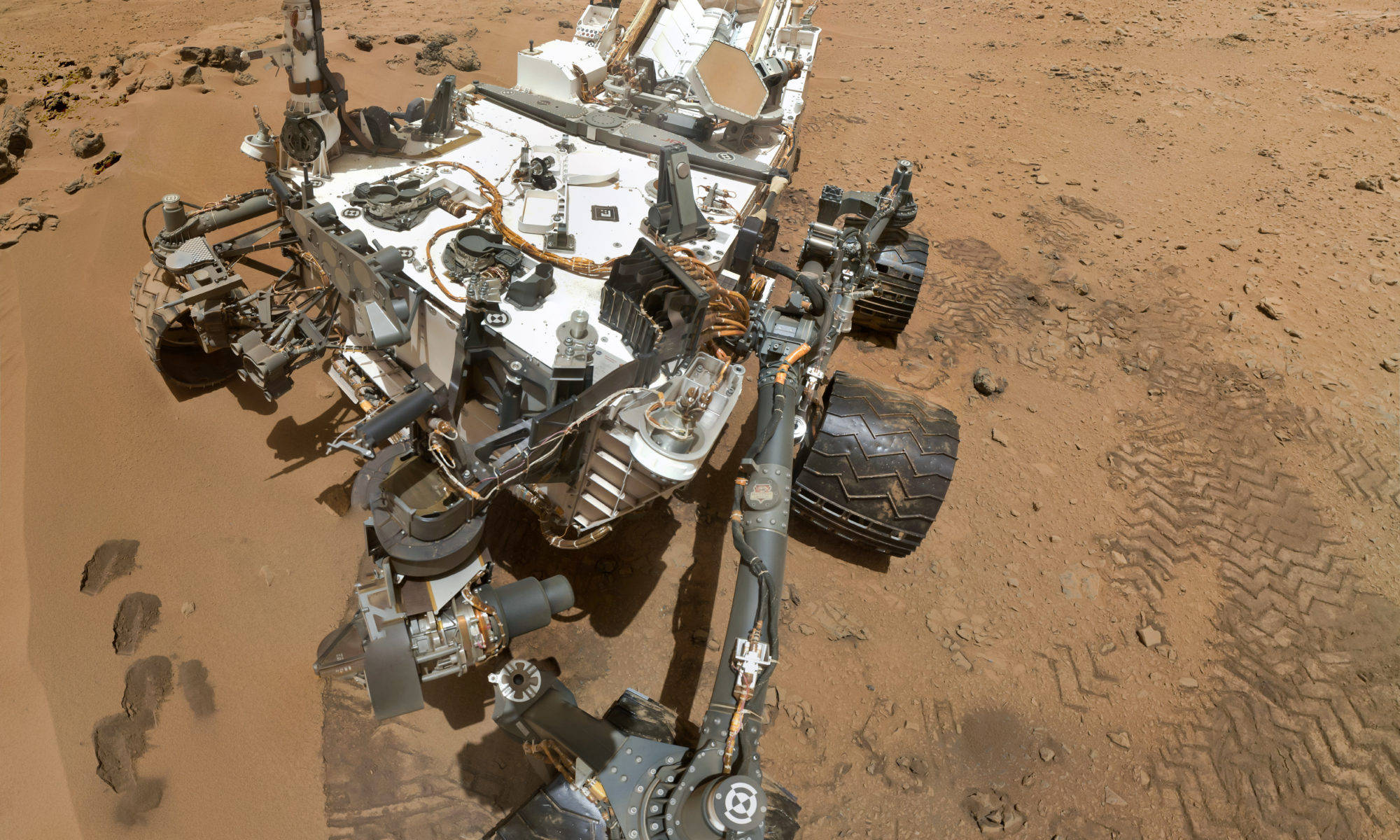Authors: Williams, Amy J., Kathleen L. Craft, Maëva Millan, Sarah Stewart Johnson, Christine A. Knudson, Marisol Juarez Rivera, Amy C. McAdam, Dominique Tobler, and John Roma Skok.
The quest to find signs of life on Mars is one of the greatest scientific challenges of our time. For some researchers, the quest is a chemical one. A search for the biomolecular remains of life that may have lived when Mars was warmer and wetter billions of years ago. However, finding and recognizing molecular fossils is no easy task, even for a rover as sophisticated as Curiosity. Now, new research from Dr. Amy Williams and her colleagues provides fresh insights into where Mars rovers should look for these fossils, what the signatures may look like, and a simple procedure for how to detect them.

Image: NASA’s Curiosity rover can drill into the surface to look for buried evidence of habitability. This is a shallow “mini drill” activity completed in 2014. This image from Curiosity’s Mars Hand Lens Imager (MAHLI) instrument shows the hole and tailings resulting from the mini drill test. The hole is 0.63 inch (1.6 centimeters) in diameter and about 0.8 inch (2 centimeters) deep. NASA/JPL-Caltech/MSSS; Public Domain.
The Mars of today is a frozen desert bombarded by radiation; no life that we know of can survive this hellish landscape. But this was not always the case. The ancient rocks reveal evidence for liquid water, which in turn implies that Mars used to enjoy a thicker atmosphere that held heat in and could have protected fledgling Martians from the harsh space environment. Scientists have even detected organic molecules which could have served as building blocks for early life. In brief, Mars had all the raw ingredients for life to emerge and, intriguingly, the timing of these fortuitous conditions aligns with the predicted emergence of life on Earth. So, while life was forming on Earth, perhaps it was also getting started on the warmer, wetter Mars of yore; if it happened here, why not there?
If life did indeed gain a foothold on Mars, it would have had only a short period within which to evolve on the surface before the climate shifted towards the desert landscape we observe today, likely halting evolution at small microbes.
So how do scientists detect life that never developed large, fossilizable body structures (e.g., bones) or the ability to leave behind other visible traces (e.g., footprints, dung)? One approach is to look for the molecular remains of life, termed chemical fossils. Since all life that we know of is cellular, the preserved components of cells – proteins, DNA, lipids, etc. – represent a promising signature of life (as we know it). Lipids are particularly valuable in the search for Martian life because they are extremely hardy. Once an organism dies, lipids can be preserved for billions of years, whereas other cellular molecules tend to decay on shorter timescales.
We know that lipids make great chemical fossils because they have been studied extensively on Earth to understand past environments and biodiversity. On Earth, these fossilized lipids are subjected to a series of analyses to isolate various molecular components that contain different pieces of information. However, several of these procedures are too complex to be miniaturized for spaceflight. NASA’s Curiosity rover instead carries a handful of “one-step” chemical experiments, which use just one reagent to extract many organic molecules at once. While these experiments are simpler, they lack many of the ‘clean-up’ steps that laboratories on Earth use, thereby requiring a more careful analysis to tease-out useful information. Further, because these “one-step” procedures re not routinely used on Earth, the effectiveness of the experiment is less well-understood.
New research from Dr. Amy Williams helps to fill these gaps. Dr. Williams led an investigation into the detection of lipids in rocks from hydrothermal springs in Iceland – an oft used location to simulate Mars given the iron-rich composition of the rocks. The researchers collected samples from both active and inactive springs to capture a range of microenvironments (lipid sources) and from various depths to better understand the preservation of buried lipids. For the analysis, the researchers focused specifically on one of the “one-step” reagents on board Curiosity, tetramethylammonium hydroxide (TMAH). It was only possible to fit a small amount of this compound onto the Curiosity rover, enough for just two experiments, which makes Dr. Williams’ work especially important. This study serves as a field test of what Curiosity can do and the result will allow researchers to better understand the effectiveness of TMAH and how to read the results, without using up the limited amount available on Mars.
Dr. Williams and her team successfully detected lipids in all their samples using the TMAH reagent. The authors discovered that even more lipids could be observed by rapidly, rather than gradually, heating the samples using a technique called flash pyrolysis. The rapid heating served to increase the reaction efficiency. Unfortunately, Curiosity was launched before this discovery was made and cannot perform flash pyrolysis, but these results could help us build better rovers in the future. Furthermore, the researchers detected lipids in the buried rocks, suggesting that they had resisted degradation for some time. This is a particularly exciting result because Mars’ surface is bombarded by radiation that can breakdown even the hardiest lipid, so rovers will likely need to drill below the surface to access any chemical fossils. Evidence that lipids can be preserved and extracted with TMAH even after being buried provides confidence in Curiosity’s ability to detect them.
In September 2020, Curiosity conducted its first targeted search for organic molecules using the TMAH reagent. Ongoing analyses indicate that the experiment was a success, but more study is required before we know if any elusive lipids were detected. In any case, Dr. Williams’ work will certainly be foundational in helping to untangle the results.

